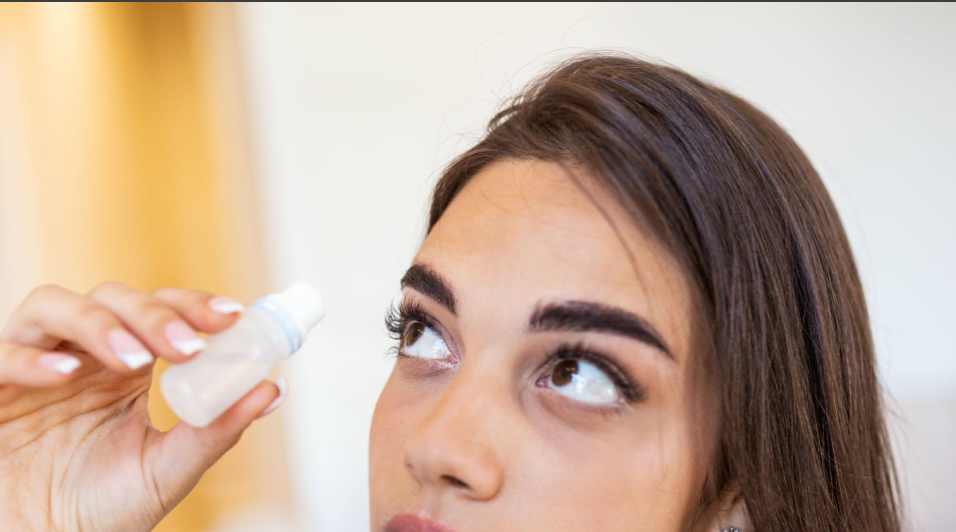Dry Eyes in Winter is a frustrating reality for millions. The season, with its cozy fireplaces and cranked-up central heating, offers a welcome respite from the cold outdoors. Yet, this same comforting environment harbors a hidden enemy for your eyes. As outdoor temperatures drop and indoor heating systems aggressively pump out warm, dry air, the relative humidity in your home plummets. This creates a challenging environment where your natural tears evaporate at an accelerated rate, leading to the painful, sandy, and sometimes blurred vision known as seasonal eye dryness.
If you’re noticing your eyes feeling grittier, redder, or more fatigued than usual from November through March, you are experiencing the effects of low humidity and environmental stress. But there is a solution. This comprehensive guide will not only give you 7 immediate, actionable tips to soothe your eyes instantly but will also dive deep into the science, preventative measures, and long-term strategies to keep your eyes comfortable, clear, and healthy through the entire cold season.
The Science Behind Seasonal Dryness
Why Winter is the Worst Season for OSD (Ocular Surface Disease)
The core problem lies in the physics of air and moisture. Cold air naturally holds less moisture than warm air. When that already dry, cold outdoor air is brought inside and heated by your furnace, its capacity to hold moisture skyrockets, but its actual moisture content (relative humidity) remains critically low. This phenomenon rapidly draws moisture from everything it touches—including your eyes—accelerating the evaporation of your tear film and creating the perfect storm for OSD.
Understanding the Tear Film in Winter
Your tear film is a crucial three-layered structure:
- Mucin Layer: The innermost layer, which helps the tears stick to the eye’s surface.
- Aqueous Layer: The middle, watery layer (the thickest part), responsible for hydration and cleaning.
- Lipid (Oil) Layer: The outermost, thin oily layer, produced by the Meibomian Glands, which seals the tear film and prevents rapid evaporation.
In winter, the low ambient humidity primarily attacks the Aqueous layer, causing it to evaporate quickly. Furthermore, if you spend a lot of time near forced air heaters, the sustained heat can sometimes thicken the oil secreted by the Meibomian Glands, leading to dysfunction (MGD), thus weakening the protective Lipid layer seal.

7 Fast Tips for Immediate Winter Dry Eye Relief
Implement these seven strategies immediately to counter the effects of low humidity and heating systems.
1. Integrate a Humidifier for Optimal Humidity
This is arguably the single most effective tool against winter dryness. Aim to keep the relative humidity in your main living areas and bedroom between 40% and 60%. A simple hygrometer can help you track this.
- Actionable Advice: Place a cool mist humidifier near your bed while sleeping and near your desk while working. Clean the unit regularly to prevent mold and bacteria growth.
2. Master the 20-20-20 Rule (and Blink Consciously)
We blink up to 60% less when looking at screens, and winter’s dry air makes this much worse. Conscious blinking is critical.
- Actionable Advice: Follow the 20-20-20 Rule (every 20 minutes, look at something 20 feet away for 20 seconds). Additionally, perform complete blinking drills: firmly squeeze your eyelids shut for two seconds every time you remember, ensuring the Meibomian Glands are properly expressed.
3. Choose the Right Artificial Tears
Not all eye drops are created equal. Avoid drops that promise to “get the red out” (decongestants), as they can cause rebound redness and worsen chronic dryness over time.
- Actionable Advice: Opt for non-preservative artificial tears (available in single-use vials) for frequent use (more than four times a day). Consider a slightly thicker gel or ointment formula specifically for nighttime use, as the lack of blinking while sleeping can cause severe morning dryness.
4. Stay Hydrated (Inside and Out)
Systemic hydration directly influences the quality and quantity of your tear production.
- Actionable Advice: Increase your daily water intake. Limit dehydrating agents like excessive caffeine and alcohol, which can pull moisture from mucous membranes, including the eyes.
💡 Did You Know? The ‘Tear Film Break-Up Time’
A healthy tear film usually remains intact for 10 seconds or more before starting to evaporate. In a low-humidity, heated winter environment, this time can drop significantly to just 2-3 seconds. This rapid breakdown is the primary cause of that sudden stinging, sandy, “dry-eye” sensation, signaling that your eyes are effectively exposed to the dry air.
5. Use Protective Eyewear Outdoors
Cold wind and extreme temperatures strip moisture from your eyes quickly, especially when engaging in outdoor activities.
- Actionable Advice: Wear wrap-around sunglasses or protective goggles whenever you are outside. These create a micro-climate around your eyes, significantly reducing airflow and preventing excessive tear evaporation (windburn).
6. Adjust Heating Vents and Car Settings
Direct hot air from vents is detrimental to tear film stability.
- Actionable Advice: Reposition yourself to avoid sitting directly in the path of home heating vents. In the car, avoid pointing the dashboard heating/defrost vents directly at your face; instead, direct them towards your feet or the side windows.
7. Try Warm Compresses
This technique addresses the often-overlooked lipid layer of the tear film, improving Meibomian Gland function.
- Actionable Advice: Apply a clean, warm compress (or a specialized heated eye mask) to your closed eyelids for 5 to 10 minutes. The heat helps liquefy the thickened oils in the glands. Follow up with a gentle massage of the eyelids to help express the healthy oils.
Long-Term Strategies and Lifestyle Adjustments
While the 7 tips provide quick relief, long-term management requires continuous lifestyle adjustments.
Optimizing Your Indoor Environment
- Air Quality: Use a high-quality air purifier with HEPA filtration. This reduces airborne irritants like dust, pet dander, and fireplace smoke, which can aggravate dry eyes in the closed-up winter environment.
- Ergonomics: Ensure your computer screen is positioned slightly below eye level. This naturally encourages your eyelids to cover more of the eye surface while viewing, reducing the exposed area and tear evaporation rate.
The Nutrition Connection: Winter Diet
Your diet plays a critical role in supporting tear quality, particularly the oily layer.
- Omega-3 Fatty Acids: Incorporate high-quality Omega-3 supplements (specifically EPA and DHA) or increase dietary sources like fatty fish. Omega-3s are anti-inflammatory and directly support the health and function of the Meibomian Glands.
- Antioxidants: Ensure adequate intake of Vitamins A, C, and E, which are vital for protecting the delicate cells of the ocular surface and mucous membranes against oxidative stress.
Contact Lens Care in Cold Weather
Contact lens wearers are particularly vulnerable to winter dryness.
- Rewetting Drops: Use approved rewetting drops frequently, even if you feel fine, to proactively maintain hydration.
- Consider Dailies: If dryness is severe, consult your eye care professional about switching to daily disposable lenses, which provide a fresh, moist lens surface every day, eliminating buildup that can worsen dryness.

Advanced and Medical Treatments
When to See a Doctor
If your symptoms persist, you experience pain, blurred vision that doesn’t clear with a blink, or persistent redness despite home care, it is time to schedule a comprehensive eye exam with an optometrist or ophthalmologist.
In-Office Solutions
- Prescription Drops: Your doctor may prescribe anti-inflammatory drops (such as Cyclosporine or Lifitegrast) to address the underlying inflammation that often accompanies chronic dry eye disease.
- Punctal Plugs: Tiny, temporary, or permanent plugs can be inserted into the puncta (the small drainage channels in your inner eyelids) to physically slow the drainage of tears, keeping your natural moisture on the eye for longer.
- MGD Treatments: For dryness caused by Lipid layer issues, in-office thermal pulsation treatments (like LipiFlow) can be used to gently heat and massage the Meibomian Glands, restoring healthy oil flow.
Frequently Asked Questions (FAQ)
Q1: Can cold weather damage my eyes permanently?
Extreme cold or wind can cause temporary irritation, excessive tearing (epiphora), and a feeling of grittiness, but it rarely causes permanent damage for the average person. However, low winter humidity, especially combined with indoor heating, can exacerbate chronic dry eye disease (OSD), potentially leading to corneal abrasions if left untreated. It’s the lack of moisture, not the cold itself, that poses the biggest risk.
Q2: Should I use a warm mist or cool mist humidifier for dry eyes?
For general eye comfort and safety, a cool mist humidifier is often recommended. While both types add moisture to the air, warm mist humidifiers can sometimes encourage the growth of bacteria or mold if not cleaned meticulously. More importantly, cool mist devices avoid the risk of burns and are generally safer for continuous use near your work or sleeping area.
Q3: Do blue light glasses help with winter dry eyes?
Blue light glasses primarily help with sleep/circadian rhythm and digital eye strain, but they can offer an indirect benefit for dryness. By reducing glare and visual stress, they might decrease eye fatigue and encourage better blinking habits. Additionally, many computer glasses offer an anti-reflective coating, which can minimize evaporation from the tear film.
Q4: Is it normal for my eyes to water (tear) excessively in the cold?
Yes, excessive tearing (epiphora) in cold, windy conditions is a common reflex. It’s your eyes’ immediate defense mechanism. The cold wind irritates the eye’s surface, triggering an overproduction of the watery (aqueous) layer of tears. Ironically, this reflex tearing often lacks the necessary oil (lipid) layer, causing it to quickly run down your face instead of staying on the eye surface, leading to both tearing and underlying dryness.
Conclusion
Winter eye dryness is common, predictable, and highly manageable. By understanding the simple science—that indoor heating and low humidity strip moisture from your eyes—you are empowered to take proactive steps. Stop treating the symptom and start managing the cause.
By implementing the 7 fast tips, investing in simple tools like a quality humidifier, and maintaining consistent protective habits, you can enjoy the winter season without the constant discomfort of dry, gritty eyes. Take control of your ocular environment today to ensure comfortable, clear vision all season long.



